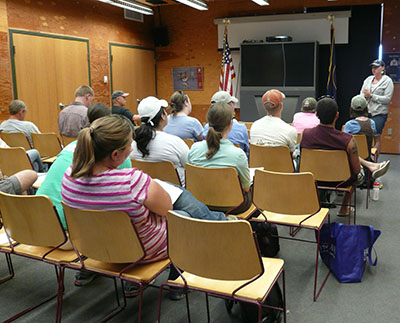Water Management
Lesson Parts
PDF of This Lesson
Purpose:
To analyze how communities deal with water shortages, distribution, and quality in designing a long-term water use plan.
Summary:
In this lesson, students will be assigned roles as community members, develop questions and positions, and participate in a mock community meeting to discuss the development of a water use plan that addresses water shortages, distribution, and water quality.
See discussion questions that provide some additional information and some leading questions about water use and water law in Utah.
The lesson is designed in four parts:
- A classroom activity that helps students understand water management;
- A mock community meeting where the students will take on a role in the community and discuss water use concerns;
- Follow up STEM activities, discussion;
- and watershed connections.
Materials Needed:
- Access to the internet. The following sites provide information on water management in Utah and the West.
- Survey of the evolution of Western Water Law

- Utah Division of Water Resources
- Utah Division of Water Rights
- Utah Division of Drinking Water
- Utah Division of Water Quality
- EPA Watershed Management
- Utah Stream Team Water Pollution and Water Regulations
Classroom Activity:
 1. Ask the students to provide examples of different water uses occurring in their community. Make a list of these uses on the board. For a complete breakdown of public water
use (residential, industrial, institutional, and commercial), and a breakdown of water
use in the home, see the Resource pages provided.
1. Ask the students to provide examples of different water uses occurring in their community. Make a list of these uses on the board. For a complete breakdown of public water
use (residential, industrial, institutional, and commercial), and a breakdown of water
use in the home, see the Resource pages provided.
2. Ask the students to tell you what kind of decisions need to be made about water
use and distribution and about protecting water quality. Some questions you might pose to the students are:
- How will water that has been used traditionally for agriculture be used in the future?
- How will the water needs of urban populations be met?
- Is there a need to build more water reservoirs and is the public willing to pay that cost?
- How does water conservation fit into this picture?
Ask them how these decisions are made. Refer to the History of Water Management and Planning in Utah since statehood.
3. Discuss with the students the importance of public input when developing water
use plans.
Mock Community Meeting:
1. Tell the students that they will be assigned different roles and participate in a mock community meeting to give their input on a water use plan focusing on water shortages, distribution and water quality. Divide the students into groups and assign them roles. Click here for a list of potential roles.
2. Tell the students that during the mock community meeting, they should discuss their
role in the community as it relates to water shortages, distribution, and water quality.
How will a change in one of these issues affect them? What are the issues they would
like to see covered in a water plan?  3. To help this activity run smoothly, assign a student to be the meeting facilitator.
Before the meeting, they should develop a list of questions and concerns to be addressed
by the group. Alternatively, this role can be played by the teacher. As a class, create
rules and guidelines for the format of the community meeting.
3. To help this activity run smoothly, assign a student to be the meeting facilitator.
Before the meeting, they should develop a list of questions and concerns to be addressed
by the group. Alternatively, this role can be played by the teacher. As a class, create
rules and guidelines for the format of the community meeting.
4. If you are limited in time, you may need to let the students come up with their
positions and needs quickly in class, and have the meeting on the same day. To give
the debate a little more context, have the students research their positions further
as an assignment and hold the community meeting another day.
NOTE: You may want to share the following resources with your students as they are formulating
their concerns and needs.
- The guidelines the Utah State Water Plan uses when developing documents
- Present and Projected Total Municipal and Industrial Water Use by Basin
- Water Prices of Various Western Cities
- Typical Water Use Within the Home
- Population Trends and Projections for Utah
- Per Capita Use of Public Water Supplies in the United States
STEM Activity:
1. After the mock community meeting, have the students write a brief summary of the
arguments presented.
2. Interview a local politician or community decision maker about the water use plan.
(Utah agencies involved in water decisions include the Divisions of Water Resources,
Water Rights, Wildlife Resources, Drinking Water and Water Quality). Other entities
include county and city governments and their planning offices; irrigation companies
and water conservancy districts).
3. Ask the students how they would decide to allocate limited water. Have students
create pie charts representing how they would allocate water to different users.
Watershed connections
What watershed do you live in?
Utah Watersheds
You can find information for each watershed here:
Curriculum and Teacher Materials
Core Alignments by Grade:
6th Grade:
7th Grade:
8th Grade:
High School:
Materials and Worksheets:
Worksheets and More:
